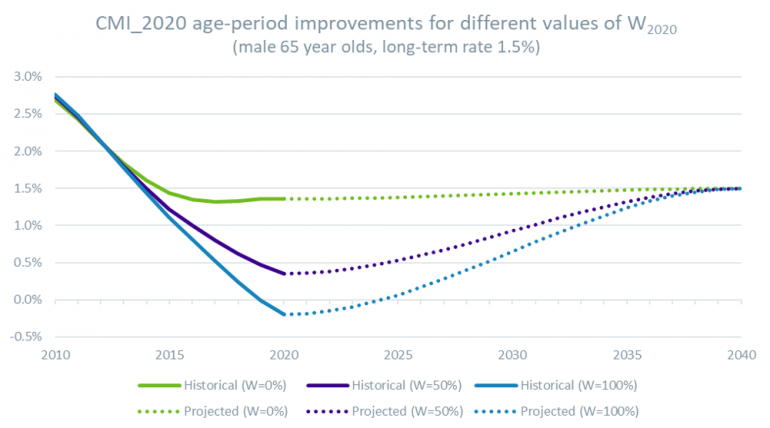Question:
What does the W parameter in the CMI mortality projections model actually do?
Answer:
The CMI projections model (CMI model) is the most common way for UK actuaries to incorporate future improvements in mortality rates into their assumptions. The model projects recent observed population level mortality improvement rates into the near future and gradually blends them into a user-defined long-term rate. Over the years, the CMI have introduced a number of parameters to allow users to tailor improvement assumptions to those judged most appropriate for a given population. The Sk parameter (introduced in CMI_2016) adjusts the smoothing of historical year-on-year improvements. The A parameter (introduced in CMI_2018) adjusts initial rates of improvement up or down. The latest CMI_2020 release introduces a new W2020 (“W”) parameter, which allows users to decide how much (if any) weight to put on 2020 mortality data – data that has heavy excess mortality.
The chart below illustrates the impact of varying the W parameter on historical and projected age-period improvements output by the model:

Key takeaways:
- The difference between including and not including 2020 data is significant. This is a consequence both of the very high mortality seen in 2020 and of the smoothing mechanism embedded in the core CMI model, which ‘overreacts’ to the extreme year seen during 2020[1].
- An allowance for 2020 data in the model affects projected improvement rates for many years into the future, and also affects the values of historical ‘observed’ improvement rates.
- The difference between a W=0% and W=100% selection will have around a 5% impact on the present value annuity for a 65 year-old man.
- The choice of a non-binary value for W is hard to conceptualise. Intuitively, a choice of e.g. W=50% might be expected to capture around half of the W=100% projection and half of the W=0% projection. That is not the case, in fact the purple W=50% projection falls much closer to the W=100% blue line.
The core version of the model sets the W parameter to 0% - i.e. no weight is placed on 2020 data and the projection represents an estimate of future mortality improvements based on population mortality improvements up to the end of 2019. A W parameter of 100% makes full allowance for the 2020 data, but most commentators would argue that it overreacts to the data and gives an implausibly pessimistic projection.
Whilst not yet released, the CMI_2021 version of the model (incorporating data up to and including 2021) is expected to introduce an additional parameter for 2021 data. This means users will need to contend with two W parameters, dictating how much weight is placed on 2020 and 2021 data respectively. Where a reduction to starting rates to reflect the pandemic is desired, it may be more intuitive to make a more explicit adjustment using the A parameter.
The key questions are:
- When considering valuation assumptions in 2022, is it too early to bake in an extended period of lower longevity improvements because of the pandemic?
- If not, how much of a headwind on future longevity improvements do you think the lingering after-effects of the pandemic will represent?
- What is the most intuitive method of incorporating your views into future longevity projections?
What do you think?
[1] This is an example of “overdispersion” – where there is greater variability in a dataset than would be expected based on the underlying statistical model. In this case, whilst the pandemic is commonly described as a 1-in-100 year event, the statistical model underlying CMI_2020 does not anticipate such an extreme change in mortality over a single year within its distribution, and therefore overreacts.




